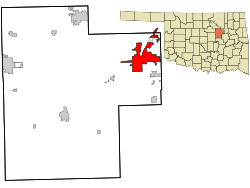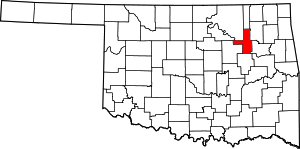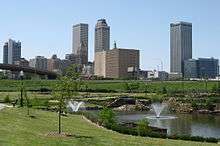Sapulpa, Oklahoma
Sapulpa is a city in Creek and Tulsa counties in the U.S. state of Oklahoma. The population was 20,544 at the 2010 United States census, compared to 19,166 at the 2000 census.[6] As of 2019 the estimated population was 21,278.[7] It is the county seat of Creek County.[8]
Sapulpa, Oklahoma | |
|---|---|
Creek County Courthouse, 2014 | |
| Motto(s): "Oklahoma's Most Connected City" | |
 Location within Creek County and Oklahoma | |
 Location in the United States | |
| Coordinates: 36°0′13″N 96°6′17″W | |
| Country | United States |
| State | Oklahoma |
| Counties | Creek, Tulsa[1] |
| Area | |
| • Total | 24.33 sq mi (63.02 km2) |
| • Land | 23.55 sq mi (61.00 km2) |
| • Water | 0.78 sq mi (2.02 km2) |
| Elevation | 715 ft (218 m) |
| Population (2010) | |
| • Total | 20,544 |
| • Estimate (2019)[3] | 21,278 |
| • Density | 903.49/sq mi (348.84/km2) |
| Demonym(s) | Sapulpan |
| Time zone | UTC-6 (Central (CST)) |
| • Summer (DST) | UTC-5 (CDT) |
| ZIP codes | 74066-74067 |
| Area code(s) | 539/918 |
| FIPS code | 40-65400[4] |
| GNIS feature ID | 1097835[5] |
| Website | www |
History
Early history
The town was named after the area's first permanent settler, a full-blood Lower Creek Indian named Sapulpa, of the Kasihta tribe, from Osocheetown in present-day Alabama]].[9] About 1850, he established a trading post near the meeting of Polecat and Rock creeks (about one mile (1.6 km) southeast of present-day downtown Sapulpa). When the Atlantic and Pacific Railroad (later known as the Frisco) built a spur to this area in 1886, it was known as Sapulpa Station. The Sapulpa post office was chartered July 1, 1889. The town was incorporated March 31, 1898.[10][11]
Controversy over Creek County seat location
After Oklahoma became a state, each county held an election to determine the location of the county seat. Sapulpa competed with Bristow as the county seat of Creek County. After five years of contested elections and court suits, the question was settled by the Oklahoma Supreme Court on August 1, 1913. Sapulpa was ruled the winner. The county courthouse was completed in 1914, replacing an earlier structure built in 1902.[9]
Economic development
The area around Sapulpa mainly produced walnuts when the town was founded. In 1898, the Sapulpa Pressed Brick was established, followed in a few years by the Sapulpa Brick Company. This began the clay products industry. Sapulpa is still the home of Frankoma Pottery.[12]
The founding of Premium Glass Company in 1912 marked Sapulpa's entry to glass manufacturing. Premium Glass was absorbed into Liberty Glass Company in 1918; the plant, after many changes in facilities and ownership, continues today under Ardagh Group, largely making beer bottles.[13][14][15] Other glass producers in the city were Bartlett-Collins Glass Company, originally opened in 1914, which was closed by subsequent owner Anchor Hocking in 2008;[16] Schram Glass Company, which opened a jar and jar cap plant in 1914 which was closed by the Ball Brothers in 1931;[17] and, The Sunflower Glass Plant, which produced window glass, began operations in 1913; and, after being leased to Victory Window Glass Co. in 1924, ceased operations in 1932.[18] According to the Encyclopedia of Oklahoma History, Sapulpa became known as "The Crystal City of the Southwest".[19]
Rail transportation
In 1889 the Frisco route between Oklahoma City and Tulsa, passing through Sapulpa, was opened.[20] The Frisco built a railyard in Sapulpa and by 1900 designated Sapulpa as the location of an overhaul base for its rolling stock.[9] Also in 1900, construction of the line from Sapulpa to Denison, Texas was started and rushed to completion by March 1901.[20] With changes in ownership over the years, the portion of the old Frisco line between Sapulpa and Del City, Oklahoma, near Oklahoma City ended up owned by the State of Oklahoma.[21] In 1998, the line was leased to Stillwater Central Railroad, and in 2014 was sold to that company.[21] The sale contract included a requirement to start a six-month daily passenger service trial run before August 2019-- known as the Eastern Flyer-- with a financial penalty for not meeting the deadline set at $2.8 million.[22] On August 5, 2019, the Stillwater Central opted to default under the contract and pay the $2.8 million penalty for not establishing the service.[23]
Separately, Sapulpa in the early days was on the route of the Sapulpa & Interurban Railway (“S&I”) streetcar/interurban line connecting to Tulsa in one direction, and Kiefer, Glenpool, and Mounds in the other. S&I subsequently went through a series of mergers and name changes, with only the Tulsa-to-Sapulpa portion continuing as the Tulsa-Sapulpa Union Railway.[24][25]
Route 66
Sapulpa is along old U.S. Route 66, now SH-66 and Historic Route 66 (a/k/a the West Ozark Trail) through town.[26] Route 66 sites include the Heart of Route 66 Auto Museum which opened in August 2016 in an Armory built in 1948. This features the world's tallest replica of an antique visible gas pump, being 66 feet in height.[27] Also still present is the Rock Creek Bridge, a/k/a the historic Bridge #18 at Rock Creek,[28] a notable 1921 metal bridge that became a link in the original Route 66 in 1926.[29]
Geography
Sapulpa is located in the northeast corner of Creek County at 36°0′13″N 96°6′17″W (36.003536, -96.104822).[30] A small portion of the city extends north into Tulsa County and was annexed into the city in 2004. Downtown Tulsa is 14 miles (23 km) to the northeast via Interstate 44. The Creek Turnpike (State Highway 364) branches east from I-44 in northeastern Sapulpa and provides a southern and eastern bypass of Tulsa.
In January 2018, the Sapulpa City Council voted to approve the annexation of approximately 300 acres of land in West Tulsa. The land is bordered to the north by 51st street, to the south by Southwest Blvd, and to the west by 65th West Avenue. Originally, this annexation included the future site of the interchange of the Gilcrease Expressway and I-44. However, the city has now planned to de-annex this area back to the city of Tulsa.
According to the United States Census Bureau, the city of Sapulpa has a total area of 25.1 square miles (65.1 km2), of which 24.3 square miles (63.0 km2) is land and 0.81 square miles (2.1 km2), or 3.21%, is water.[31]
Demographics
| Historical population | |||
|---|---|---|---|
| Census | Pop. | %± | |
| 1900 | 891 | — | |
| 1910 | 8,283 | 829.6% | |
| 1920 | 11,634 | 40.5% | |
| 1930 | 10,533 | −9.5% | |
| 1940 | 12,249 | 16.3% | |
| 1950 | 13,031 | 6.4% | |
| 1960 | 14,282 | 9.6% | |
| 1970 | 15,159 | 6.1% | |
| 1980 | 15,853 | 4.6% | |
| 1990 | 18,074 | 14.0% | |
| 2000 | 19,166 | 6.0% | |
| 2010 | 20,544 | 7.2% | |
| Est. 2019 | 21,278 | [3] | 3.6% |
| Sources:[4][32][33] | |||
As of the 2010 census, there were 20,544 people, 8,015 households, and 5,497 families residing in the city. The population density was 844.3 people per square mile. There were 8,903 housing units at an average density of 435.4 per square mile (168.2/km2). The racial makeup of the city was 77.5% White, 3.0% African American, 10.9% Native American, 0.6% Asian, 0.2% Pacific Islander, 1.5% from other races, and 6.3% from two or more races. Hispanic or Latino of any race were 4.1% of the population.[34]
There were 7,430 households out of which 32.5% had children under the age of 18 living with them, 54.8% were married couples living together, 12.9% had a female householder with no husband present, and 27.9% were non-families. 24.2% of all households were made up of individuals and 10.5% had someone living alone who was 65 years of age or older. The average household size was 2.54 and the average family size was 3.00.
In the city, the population was spread out with 26.1% under the age of 18, 7.9% from 18 to 24, 27.5% from 25 to 44, 23.7% from 45 to 64, and 14.8% who were 65 years of age or older. The median age was 37 years. For every 100 females, there were 91.2 males. For every 100 females age 18 and over, there were 86.9 males.
The median income for a household in the city was $40,372 and the median income for a family was $52,639. Males had a median income of $30,524 versus $21,609 for females. The per capita income for the city was $22,275. About 11.5% of families and 16.3% of the population were below the poverty line, including 15.2% of those under age 18 and 17.4% of those age 65 or over.[35]
Culture and education
Sapulpa has an organization known as Sapulpa Main Street, one of the various national Main Street programs, the purpose of which is to preserve and enhance the cultural heritage of the town, and to improve its quality of life, by revitalizing the Central Business District as the center of the Community.[36]
In 2013, the Sapulpa Creek Community Center graduated a class of 14 from its Muscogee Creek language class.[37]
Historical sites
The following are NRHP-listed sites in Okmulgee:
- Berryhill Building (14-20 E. Dewey)
- Bridge No. 18 at Rock Creek (the junction of old US Route 66 and Rock Creek)
- Creek County Courthouse (222 E. Dewey Ave.)
- John Frank House (1300 Luker Ln.)
- McClung House (708 S. Main St.)
- Sapulpa Downtown Historic District (roughly bounded by Hobson Ave, Elm St., Lee Ave, & Main St)
- West Sapulpa Route 66 Roadbed (junction of Ozark Trail of State 66 .25 miles west of Sahoma Lake Rd)
Parks and recreation
The Sapulpa Parks and Recreation System includes twenty-one parks and recreation facilities, including 501 land acres. Sixteen sites are considered developed and open to the public, while five are not yet developed. Kelly Lane Park Trail, Liberty Park Trail, Davis Park Trail, Hollier Park Trail, and Pretty Water Lake Trail offer one-quarter-mile to one-mile walking experiences.[38] Among other facilities is Pretty Water Lake, spring-fed and 25-acres large, open for fishing and stocked with trout and channel catfish/panfish.[39] Sahoma Lake covers 277 acres,[40] and fishing opportunities there include largemouth bass, smallmouth bass, channel catfish, crappie, perch, blue gill, and redear perch.[41]
Newspaper controversy
The Sapulpa Daily Herald gained national media attention in early November 2008 for not reporting the election of Barack Obama as president, reporting only that John McCain had won among the voters of Creek County. Critics charged that the omission related to racism, as Obama's victory as the first African American elected president was an historic event. The newspaper maintains that it only covers local news events. The newspaper had covered every single presidential victory prior to the Obama victory.[42]
Notable people
- Joni Rogers Kante, founder of SeneGence Intl.
- Bob Ballinger, Republican member of the Arkansas House of Representatives, taught history in Sapulpa from 1999 to 2002.[43]
- The Collins Kids, musicians, Lorrie and Larry Collins, resided near Sapulpa in the early 1950s.[44]
- Joe Haymes, jazz orchestra leader, lived here for extended periods in the 1940s and '50s.[45]
- Regina Holliday, art teacher, artist, muralist, and patient rights advocate, graduated from Sapulpa High School.
- William Miller Jenkins (April 25, 1856 - October 19, 1941), a native of Ohio, was appointed as the fifth governor of the Territory of Oklahoma in 1901 and dismissed in the same year, after allegations of fiscal impropriety. He moved to Sapulpa,in 1920, where he lived in retirement for the rest of his life
- George William Miller (b. March 9, 1925 – d. March 17, 2006) was born in Sapulpa. He served as the 65th U.S. Secretary of the Treasury under President Carter from August 6, 1979, to January 20, 1981. He previously served as the 11th Chairman of the Federal Reserve, where he began service on March 8, 1978.
- Shara Nova, lead singer and songwriter for My Brightest Diamond, grew up in Sapulpa.[46] She was previously a backup vocalist for Sufjan Stevens and the frontwoman of Awry.
References
- "Zoning Index" (PDF). Archived from the original (PDF) on January 17, 2009.
- "2019 U.S. Gazetteer Files". United States Census Bureau. Retrieved July 28, 2020.
- "Population and Housing Unit Estimates". United States Census Bureau. May 24, 2020. Retrieved May 27, 2020.
- "American FactFinder". United States Census Bureau. Archived from the original on 2020-02-12. Retrieved 2008-01-31.
- "US Board on Geographic Names". United States Geological Survey. 2007-10-25. Retrieved 2008-01-31.
- "MuniNet Guide: Sapulpa, Oklahoma". Archived from the original on 2012-01-27. Retrieved 2011-05-30.
- "Population and Housing Unit Estimates". Retrieved May 21, 2020.
- "Find a County". National Association of Counties. Retrieved 2011-06-07.
- "Sand Springs | The Encyclopedia of Oklahoma History and Culture". www.okhistory.org.
- Sapulpa Historical Society. "Area History."
- "City of Sapulpa, "Connect to Sapulpa's Heritage."". Archived from the original on September 6, 2011.
- "Welcome to the Frankoma Pottery Company". Frankoma Pottery. Retrieved March 16, 2020.
- "Sapulpa glass plant makes millions of beer bottles". Phil Mulkins, Tulsa World, January 7, 2014. Retrieved October 14, 2019.
- "Ardagh Group signs definitive Share Purchase Agreement to acquire Verallia North America". Ardagh Group. Retrieved October 14, 2019.
- "Locations". Ardagh Group. Retrieved October 14, 2019.
- "Sapulpa glass plant to be shut down". David Schulte, Tulsa World, February 1, 2008. Retrieved October 14, 2019.
- "The Schram Companies" (PDF). Society for Historical Archaeology Inc. Retrieved October 14, 2019.
- "The History of Sapulpa OK" (PDF). Sapulpa Historical Society, Inc. Retrieved July 18, 2020.
- Dianna Everett, "Glass Manufacturing." Encyclopedia of Oklahoma History and Culture. Retrieved September 1, 2011.
- "A Condensed History of the Frisco Railroad". thelibrary.org. Retrieved January 31, 2019.
- "Sooner Sub railroad sale finalized". Curtis Killman, Tulsa World, August 5, 2014. Retrieved January 31, 2019.
- "Passenger rail between Tulsa and OKC? Company seeks another Eastern Flyer operator". Kyle Hinchey, Tulsa World, June 22, 2018. Retrieved January 25, 2019.
- "OKC-to-Tulsa passenger rail service falls through". Randy Ellis, Tulsa World, August 6, 2019. Retrieved August 6, 2019.
- "Tulsa streetcar and interurban lines in Google Maps". Michael Bates. Retrieved January 18, 2019.
- "Tulsa Sapulpa Union Railway". American-Rails.com. Retrieved January 18, 2019.
- "Sapulpa, Oklahoma". Google Maps. Retrieved October 15, 2019.
- John Klein, “Site Worth Seeing,” Tulsa World, August 21, 2018.
- "Sapulpa". theroute-66.com. Retrieved October 15, 2019.
- "Rock Creek Bridge". Tripadvisor. Retrieved October 15, 2019.
- "US Gazetteer files: 2010, 2000, and 1990". United States Census Bureau. 2011-02-12. Retrieved 2011-04-23.
- "Geographic Identifiers: 2010 Demographic Profile Data (G001): Sapulpa city, Oklahoma". U.S. Census Bureau, American Factfinder. Archived from the original on March 9, 2015. Retrieved March 6, 2015.
- "Number of Inhabitants: Oklahoma" (PDF). 18th Census of the United States. U.S. Census Bureau. Retrieved 22 November 2013.
- "Oklahoma: Population and Housing Unit Counts" (PDF). U.S. Census Bureau. Retrieved 22 November 2013.
- Bureau, U. S. Census. "American FactFinder - Results". factfinder.census.gov. Archived from the original on 2014-03-05. Retrieved 2019-07-13.
- Bureau, U. S. Census. "American FactFinder - Results". factfinder.census.gov. Archived from the original on 2020-02-12. Retrieved 2019-07-13.
- "Home". Sapulpa Main Street. Retrieved March 16, 2020.
- Brock, John (2013-08-17). "Creek language class graduates 14". Sapulpa Herald Online. Sapulpa, Oklahoma. Archived from the original on 2013-08-23. Retrieved 2013-08-23.
- "Sapulpa Parks". City of Sapulpa. Retrieved April 6, 2020.
- "Pretty Water Lake". City of Sapulpa. Retrieved April 8, 2020.
- The 1947 specifications for Sahoma put the area of the lake at 344 acres at the normal pool elevation of 716’, with a cumulative volume of 4,850 acre-feet of water. However, the 2011 hydrographic survey by the Oklahoma Water Resources Board put the lake’s area at 277 acres, with a cumulative volume of 2,543 acre-feet of water. The Board cautioned that at least some of the difference in the numbers might be due to differing measurement methods, rather than simple sedimentation. "Hydrographic Survey of Sahoma Lake, Final Report, October 31, 2011, pages 10-11" (PDF). Oklahoma Water Resources Board. Retrieved April 11, 2020.
- "Sahoma Lake". City of Sapulpa. Retrieved April 8, 2020.
- "Video News". CNN.
- "Dan Douglas' Biography". votesmart.org. Retrieved January 7, 2013.
- "Encyclopedia Of Country, Western, & Gospel Music P0305".
- Paul Lindemeyer, "Joe Haymes: Lost Motion." IAJRC Journal, summer, 1993.
- "Progress Report: My Brightest Diamond". October 19, 2011.
External links
- City of Sapulpa official website
- Jackson, Pauline P. "The Sapulpa and Bristow County Seat Contest." Accessed August 31, 2011 CONTENTdm


